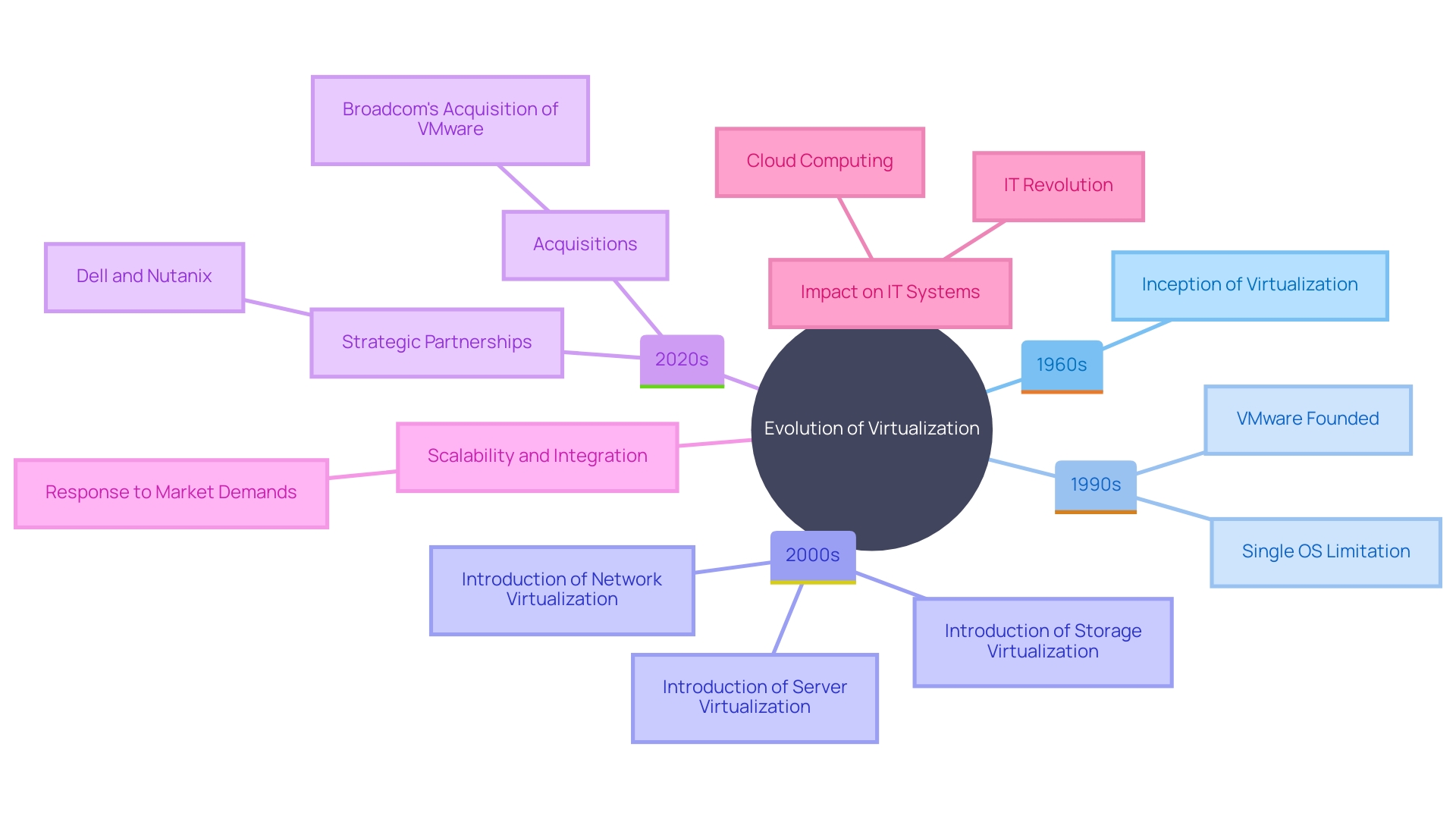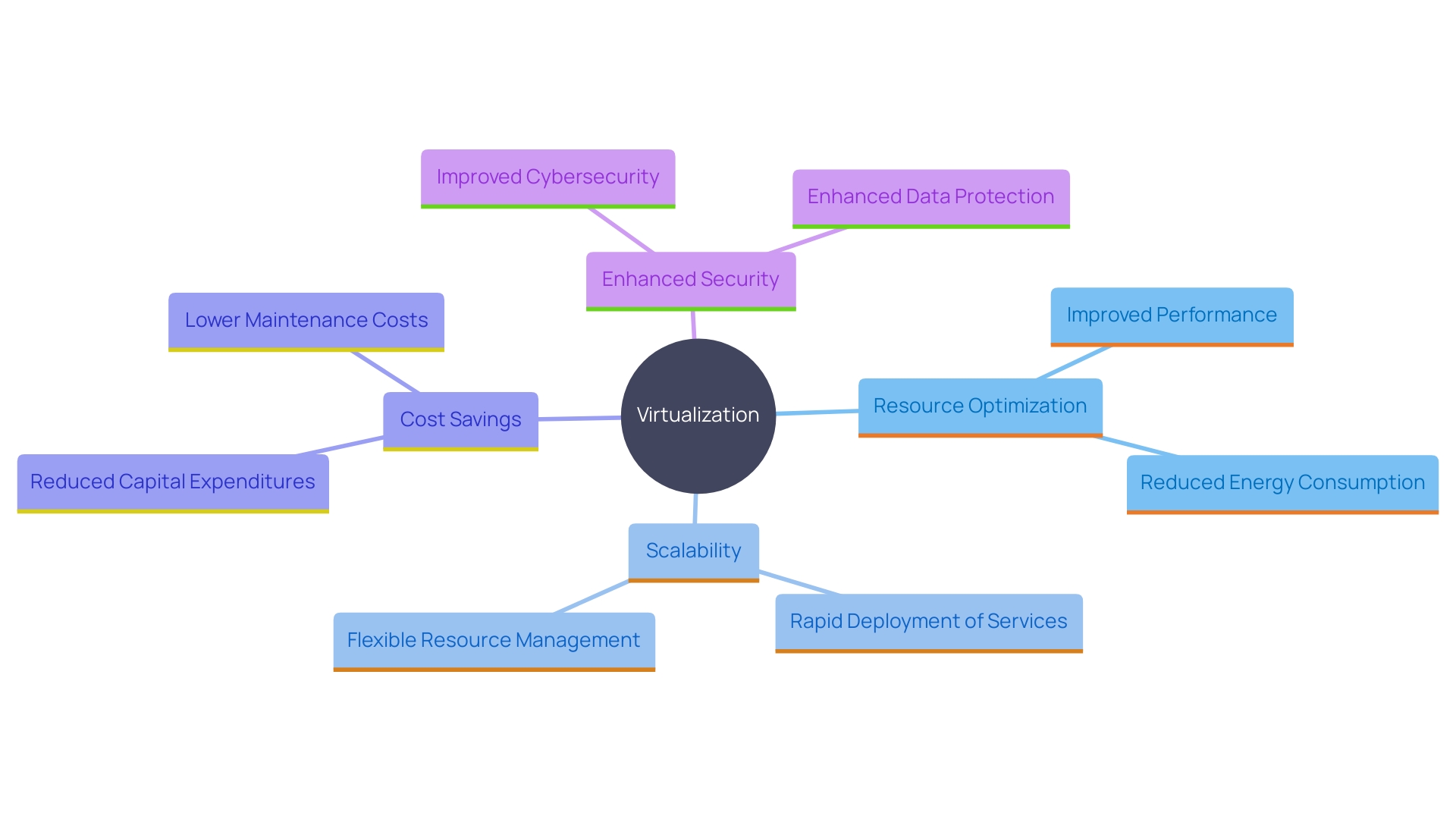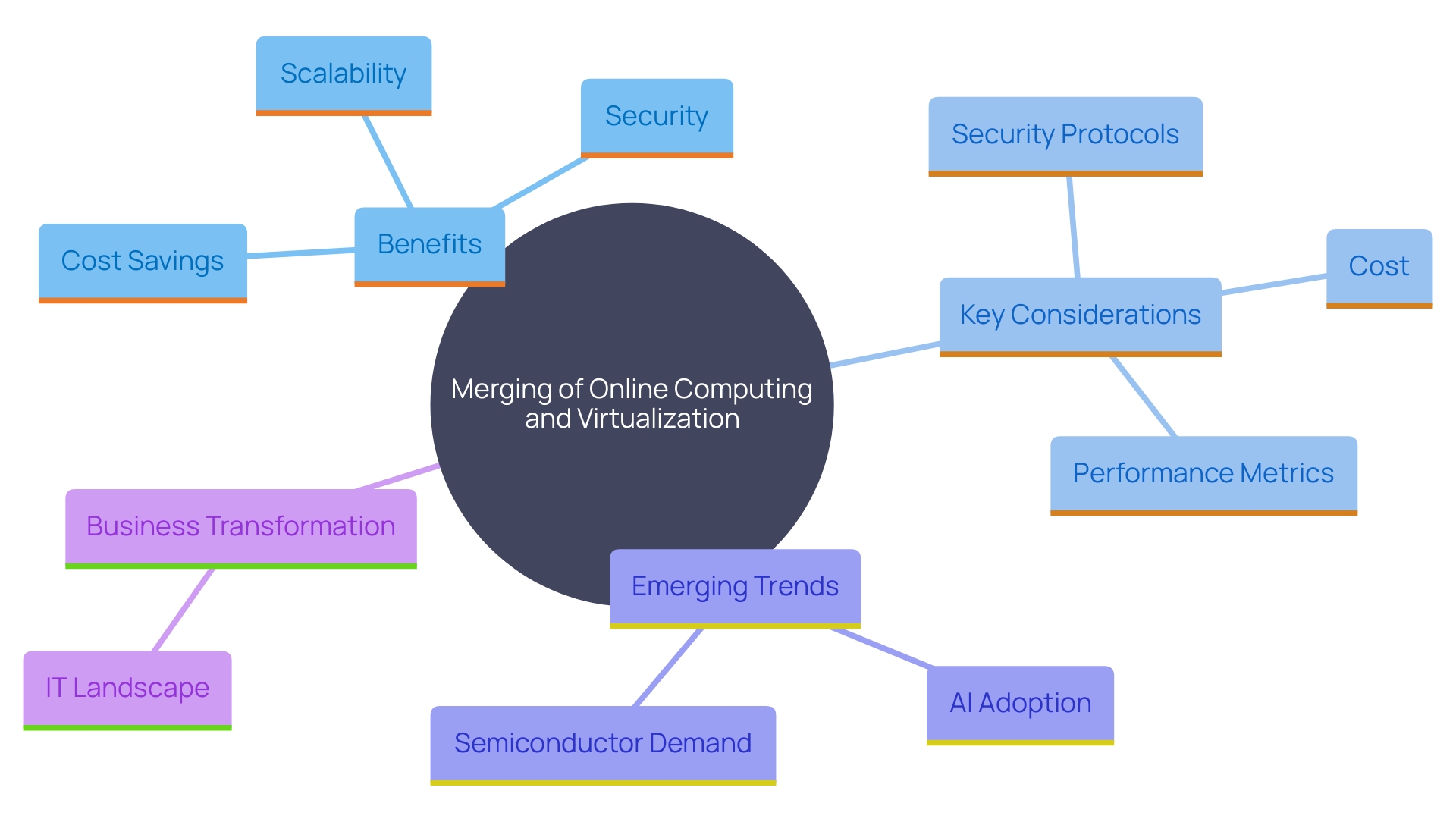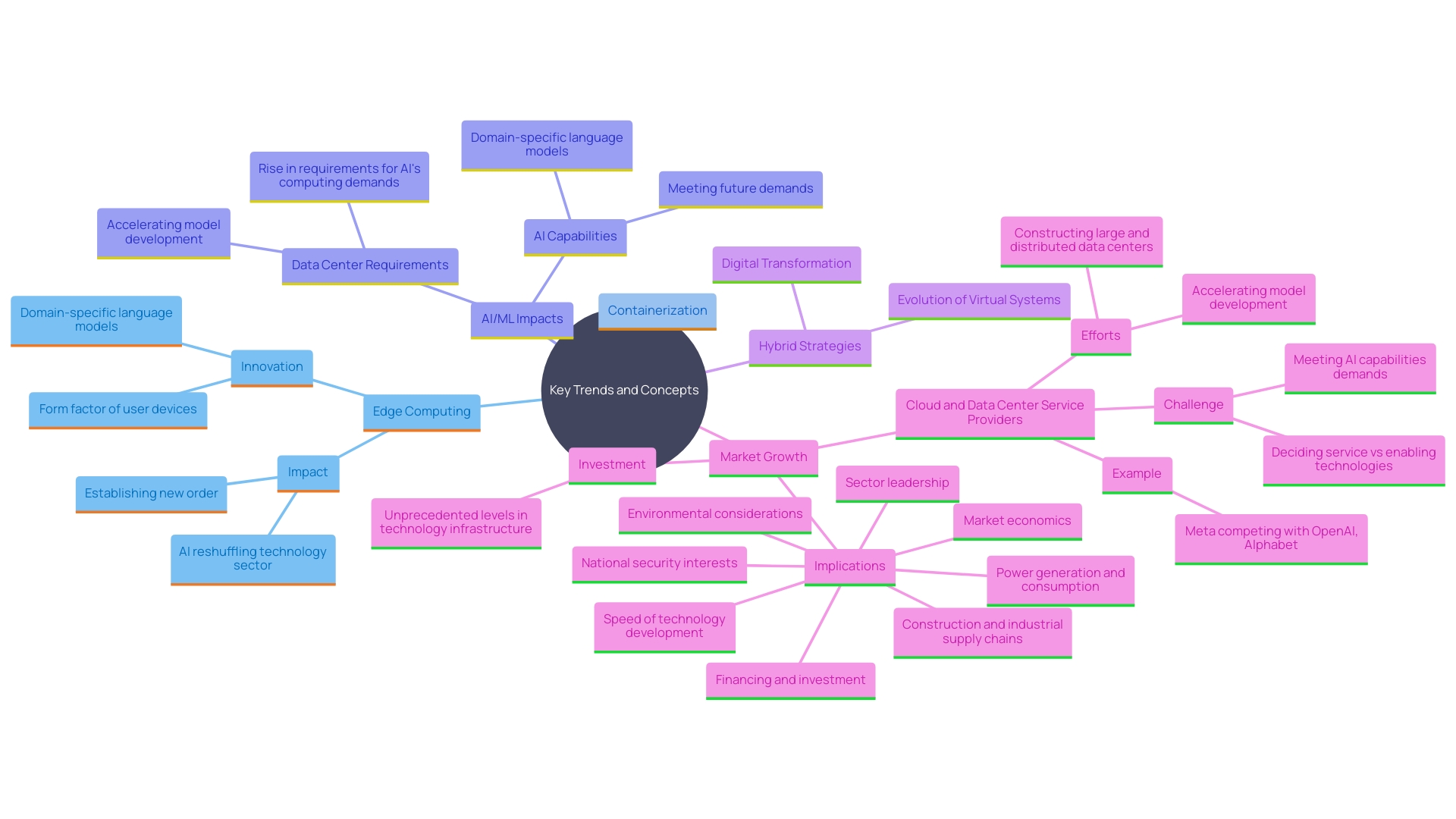Introduction
Virtualization has undergone a profound transformation since its origins in the 1960s, initially serving as a method to optimize resource utilization in mainframe computers. The evolution of virtualization technologies, propelled by significant advancements in both hardware and software, has led to the development of virtual environments that emulate physical machines. This advancement encompasses various forms of virtualization, including server, storage, and network virtualization, which collectively empower businesses to operate more efficiently and respond rapidly to market demands.
Strategic collaborations and acquisitions have been instrumental in the progression of virtualization technologies. Noteworthy partnerships, such as that between Dell and Nutanix, have introduced enhanced deployment flexibility and simplicity in hyper-converged infrastructure solutions. Similarly, Broadcom’s acquisition of VMware underscores the competitive dynamics reshaping the industry.
As virtualization infrastructure becomes increasingly integral to the adoption of cloud operating models, the importance of scalability and integration in modern IT infrastructure cannot be overstated. The ongoing technological advancements and strategic business maneuvers highlight the necessity for robust and adaptable IT solutions, transforming the way businesses function and maintain productivity.
The Evolution of Virtualization
Virtualization has evolved remarkably since its inception in the 1960s, where it started as a method to maximize resource utilization in mainframe computers. Today, technology for creating virtual systems has progressed significantly, driven by hardware and software innovations, enabling the formation of environments that mimic physical machines. 'This progression has resulted in various types of emulation such as server, storage, and network emulation, which collectively assist businesses in operating more efficiently and responding swiftly to market demands.'.
Strategic partnerships and acquisitions have played pivotal roles in advancing technology for creating virtual environments. Significantly, the partnership between Dell and Nutanix has brought forth new deployment flexibility and simplicity in hyper-converged systems (HCI) solutions. The latest expansion of their partnership, which includes the deployable Dell PowerEdge XC Plus and integration of PowerFlex software-defined storage, represents a strategic move to gain a competitive edge in the market. Similarly, Broadcom’s acquisition of VMware highlights the competitive pressures reshaping the industry.
These advancements are essential as virtual systems become increasingly important in the rising adoption of cloud operating models. The market dynamics, influenced by technological advancements and strategic business moves, highlight the significance of scalability and integration in contemporary IT systems. As highlighted by industry experts, the ongoing evolution of the technology landscape will continue to transform how businesses operate and remain productive, emphasizing the necessity of robust and adaptable IT solutions.

Types of Virtualization
Virtualization comprises several types, each tailored to address specific organizational needs and drive efficiency. Server abstraction allows the setup of several virtual servers on one physical server, greatly enhancing resource use. This approach not only enhances performance but also supports scalability—a crucial factor in modern data centers where rapid scaling to meet workload demands is essential. For instance, the deployment of 6,000 virtual machines and 15,000 pods utilizing Red Hat OpenShift® Virtualization demonstrates the capability to manage large-scale infrastructures efficiently.
Desktop emulation offers virtual desktop settings reachable from any location, thereby boosting productivity and adaptability. This is particularly beneficial for organizations with a high percentage of knowledge workers and specialists who require substantial technical capabilities and support for multitasking. Leading solutions, such as those from Cisco Compute, offer validated designs tested to ensure balanced performance and optimal installation, reducing implementation time and costs.
Storage abstraction combines several storage devices into one, manageable entity. This consolidation streamlines administration and enhances asset utilization, as demonstrated by NetApp® storage solutions, which propel business transformation through effective asset management and simpler deployment of applications.
Network virtualization abstracts network resources to improve management and security. The convergence of network, cloud, and security teams is becoming increasingly important as enterprises adopt more complex, integrated solutions. HPE's acquisition of Juniper Networks highlights the industry's move towards expanding data center capabilities and enhancing network management. This integration supports the development of scalable, secure, and efficient network infrastructures.
Every category of abstraction provides distinct advantages, ranging from maximizing asset usage and increasing adaptability to boosting safety and streamlining administration, thus fostering creativity and effectiveness within enterprises.
Benefits of Virtualization
Virtualization stands as a cornerstone of contemporary IT strategies, delivering a multitude of advantages. One of the primary benefits is resource optimization. By consolidating workloads on fewer physical servers, organizations can significantly enhance performance and reduce energy consumption. For instance, Rackspace Technology's collaboration with CAS led to optimized deployment and substantial cost reductions, showcasing how technology can drive efficiency.
Scalability is another key benefit, allowing businesses to swiftly deploy new applications and services without hefty hardware investments. This flexibility was evident when a leading cloud provider partnered with Insight to open 18 new data centers globally, demonstrating the critical role scalability plays in modern IT infrastructures.
Cost savings are also a significant benefit of using virtual environments. By cutting down on hardware expenses and maintenance overheads, organizations can allocate resources more effectively. The worldwide market for software that creates virtual environments, valued at approximately $6 billion in 2020, underlines its widespread adoption and cost-efficiency.
Moreover, the use of virtual systems enhances security and isolation by containing applications within their own virtual environments. This minimizes the risk of cross-contamination and strengthens overall data protection. As noted by industry experts, the technology of creating virtual instances has long been the backbone of data centers, enabling them to run multiple operating systems and applications on a single physical server, thereby maximizing hardware utilization and reducing costs.
In a time when the online computing sector is anticipated to expand at a compound annual growth rate of over 18%, fueled by elements such as AI and IoT integration, this technology remains essential. It not only streamlines operations but also supports the evolving needs of businesses, making it an indispensable component of IT ecosystems.

Cloud Computing and Virtualization
The merging of online computing and virtualization has fundamentally changed IT service delivery. Virtualization acts as the foundation of online infrastructure, enabling on-demand asset distribution and scalability. This synergy allows organizations to access virtualized resources without substantial upfront investments, which enables them to concentrate on core business operations. Additionally, this integration promotes agility, allowing businesses to swiftly adapt to market shifts and customer demands while ensuring high availability and robust disaster recovery capabilities.
Security considerations are paramount in this scenario. It's essential to evaluate the security protocols and measures offered by potential service providers to safeguard sensitive data and comply with industry regulations. Cost considerations also play a crucial role in the decision-making process, encompassing the total cost of ownership, potential savings, and any hidden expenses associated with migration. Performance metrics, including quality of service, scalability, availability, and reliability, must also be carefully assessed to ensure that the selected solution meets the organization's operational requirements.
The benefits of transitioning to cloud-managed services are numerous, including cost savings, improved scalability and flexibility, enhanced security, and access to expert support and guidance. By outsourcing the management of online infrastructure, organizations can focus on their core functions while leaving technical details to experts. When selecting a cloud-managed services provider, it's important to consider their experience, expertise, and track record to ensure a smooth and effective transition.
In 2022, Grand View Research estimated that the computing sector would produce $1.6 trillion in revenue by 2030, propelled by industries such as banking, financial services, IT, telecom, and retail. This vast and intricate system requires comprehensive knowledge and abilities, emphasizing the significance of specialized training and qualifications for computing positions. Moreover, the adoption of emerging technologies like AI is expected to further boost semiconductor demand, reinforcing the need for scalable and efficient data center infrastructure.
Overall, the collaboration between cloud computing and the use of virtual environments is crucial in driving business transformation, providing organizations the flexibility, security, and efficiency required to succeed in today's dynamic market landscape.

Future Trends in Virtualization
As technology continues to evolve, the environment of virtual systems is poised for significant advancement. The rise of edge computing is driving a shift towards decentralized virtualization solutions, enabling data processing to occur closer to the data source. This approach reduces latency and enhances real-time decision-making, which is critical for industries leveraging IoT and AI-driven applications.
Containerization is becoming increasingly popular, offering lightweight application deployment and orchestrating capabilities that enhance efficiency and scalability. The adoption of containerization is further fueled by the growing demand for microservices architecture, which supports the seamless integration of diverse applications within virtualized environments.
Artificial intelligence (AI) and machine learning (ML) are poised to transform asset management and optimization within virtualized infrastructures. AI-driven algorithms can dynamically allocate resources, predict system failures, and optimize performance, thereby reducing operational costs and improving system reliability.
These trends emphasize that the use of virtual environments remains a cornerstone of IT strategy, facilitating digital transformation and fostering innovation. The computing market, valued at $723.4 billion in 2023, is anticipated to expand at a compound annual growth rate (CAGR) of over 18% during the forecast period, propelled by elements such as the integration of IoT devices, rising demand for AI, and the broad adoption of DevOps practices.
As the industry works to build data centers of the future, the scalability of equipment, including cooling, power, and protection, continues to be a key consideration. Companies like Meta are competing to secure leadership roles in developing large language models, highlighting the ongoing race to enhance AI capabilities and meet future demands.
The virtualization environment is also shaped by the growing presence of hybrid strategies. A survey reveals that 64% of respondents have already implemented a hybrid approach, with 38% planning to enhance their adoption of hybrid cloud within the upcoming year. This shift underscores the need for flexible, efficient, and secure virtualized environments that can support the evolving needs of modern enterprises.

Conclusion
The evolution of virtualization has profoundly transformed IT infrastructure, shifting from a resource optimization tool in the 1960s to a critical technology for enhancing operational efficiency. Various forms, such as server, storage, and network virtualization, enable organizations to respond rapidly to market demands. Strategic partnerships and acquisitions, like those between Dell and Nutanix and Broadcom’s acquisition of VMware, illustrate the competitive dynamics of the industry.
Each virtualization type serves specific organizational needs, optimizing resource utilization, enhancing productivity through remote access, simplifying management, and improving security. The benefits include increased scalability, significant cost savings, and enhanced security by isolating applications, solidifying virtualization as a vital aspect of modern IT strategies.
As the cloud computing market expands, the integration of virtualization with cloud services fosters agility and helps businesses adapt to changing demands. Future trends, including edge computing, containerization, and artificial intelligence, promise to further revolutionize resource management and operational efficiency.
In summary, virtualization is a cornerstone of IT strategy that drives innovation and supports sustainable growth. As organizations navigate the complexities of the digital landscape, robust and adaptable virtualized environments will be essential for achieving long-term success.




